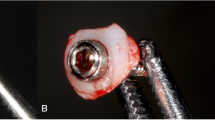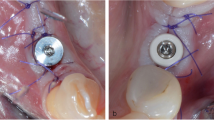Abstract
The aim of the present pilot study was to histologically/immunohistochemically investigate initial and early subepithelial connective tissue attachment at transmucosal parts of modified (mod) and conventional sandblasted, large grit and acid-etched (SLA) titanium implants. Implantation of modSLA and SLA implants was performed bilaterally in both the mandible and maxilla of four beagle dogs. The implants were submerged to prevent bacterial contamination. The animals were killed after 1, 4, 7 and 14 days. Peri-implant tissue reactions were assessed histologically (Masson Goldner Trichrome stain-MG) and immunohistochemically (IH) using monoclonal antibodies to fibronectin (FN) and proliferating cell nuclear antigen (PCNA). The surgical procedure of implant submerging resulted in the formation of an artificial gap in the transmucosal area of both types of implants. After 14 days of healing, MG stain revealed the formation of well-organized collagen fibres and numerous blood vessels in a newly formed loose connective tissue zone adjacent to modSLA. While some fibres were oriented in a parallel direction, others have started to extend and attach partially perpendicular to the implant surface. In contrast, SLA implants appeared to be clearly separated by a dense connective tissue zone with parallel-running collagen fibres and rare blood vessel formation. First signs of a positive FN and PCNA staining adjacent to both implant surfaces were observed at day 4. Within the limits of a pilot study, it might be concluded that modSLA titanium surfaces might possess the potential to promote subepithelial connective tissue attachment at the transmucosal part of the implant.






Similar content being viewed by others
References
Abrahamsson I, Berglundh T, Glantz PO, Lindhe J (1998) The mucosal attachment at different abutments. An experimental study in dogs. J Clin Periodontol 25:721–727
Abrahamsson I, Berglundh T, Moon IS, Lindhe J (1999) Peri-implant tissues at submerged and non-submerged titanium implants. J Clin Periodontol 26:600–607
Abrahamsson I, Berglundh T, Wennstrom J, Lindhe J (1996) The peri-implant hard and soft tissues at different implant systems. A comparative study in the dog. Clin Oral Implants Res 7:212–219
Albrektsson T (1983) Direct bone anchorage of dental implants. J Prosthet Dent 50:255–261
Albrektsson T, Isidor F (1994) Consensus report of session IV. In: Lang, NP, Karring, T (eds) Proceedings of the first European workshop on periodontology. Quintessence, London, pp 365–369
Becker J, Kirsch A, Schwarz F, Chatzinikolaidou M, Rothamel D, Lekovic V, Laub M, Jennissen HP (2006) Bone apposition to titanium implants biocoated with recombinant human bone morphogenetic protein-2 (rhBMP-2). A pilot study in dogs. Clin Oral Investig 10:217–224
Berglundh T, Lindhe J (1996) Dimension of the periimplant mucosa. Biological width revisited. J Clin Periodontol 23:971–973
Berglundh T, Lindhe J, Ericsson I, Marinello CP, Liljenberg B, Thomsen P (1991) The soft tissue barrier at implants and teeth. Clin Oral Implants Res 2:81–90
Berglundh T, Lindhe J, Jonsson K, Ericsson I (1994) The topography of the vascular systems in the periodontal and peri-implant tissues in the dog. J Clin Periodontol 21:189–193
Bollen CM, Lambrechts P, Quirynen M (1997) Comparison of surface roughness of oral hard materials to the threshold surface roughness for bacterial plaque retention: a review of the literature. Dent Mater 13:258–269
Brånemark PI, Hansson BO, Adell R, Breine U, Lindstrom J, Hallen O, Ohman A (1977) Osseointegrated implants in the treatment of the edentulous jaw. Experience from a 10-year period. Scand J Plast Reconstr Surg Suppl 16:1–132
Buser D, Broggini N, Wieland M, Schenk RK, Denzer AJ, Cochran DL, Hoffmann B, Lussi A, Steinemann SG (2004) Enhanced bone apposition to a chemically modified SLA titanium surface. J Dent Res 83:529–533
Buser D, Weber HP, Donath K, Fiorellini JP, Paquette DW, Williams RC (1992) Soft tissue reactions to non-submerged unloaded titanium implants in beagle dogs. J Periodontol 63:225–235
Chehroudi B, Gould TR, Brunette DM (1992) The role of connective tissue in inhibiting epithelial downgrowth on titanium-coated percutaneous implants. J Biomed Mater Res 26:493–515
Cochran DL, Hermann JS, Schenk RK, Higginbottom FL, Buser D (1997) Biologic width around titanium implants. A histometric analysis of the implanto-gingival junction around unloaded and loaded nonsubmerged implants in the canine mandible. J Periodontol 68:186–198
Donath K (1985) The diagnostic value of the new method for the study of undecalcified bones and teeth with attached soft tissue (Säge–Schliff (sawing and grinding) technique). Pathol Res Pract 179:631–633
Ericsson I, Nilner K, Klinge B, Glantz PO (1996) Radiographical and histological characteristics of submerged and nonsubmerged titanium implants. An experimental study in the Labrador dog. Clin Oral Implants Res 7:20–26
Fartash B, Arvidson K, Ericsson I (1990) Histology of tissues surrounding single crystal sapphire endosseous dental implants: an experimental study in the beagle dog. Clin Oral Implants Res 1:13–21
Fujii N, Kusakari H, Maeda T (1998) A histological study on tissue responses to titanium implantation in rat maxilla: the process of epithelial regeneration and bone reaction. J Periodontol 69:485–495
Gotfredsen K, Rostrup E, Hjorting-Hansen E, Stoltze K, Budtz-Jorgensen E (1991) Histological and histomorphometrical evaluation of tissue reactions adjacent to endosteal implants in monkeys. Clin Oral Implants Res 2:30–37
Guy SC, McQuade MJ, Scheidt MJ, McPherson JC, 3rd, Rossmann JA, Van Dyke TE (1993) In vitro attachment of human gingival fibroblasts to endosseous implant materials. J Periodontol 64:542–546
Hormia M, Kononen M (1994) Immunolocalization of fibronectin and vitronectin receptors in human gingival fibroblasts spreading on titanium surfaces. J Periodontal Res 29:146–152
Lindhe J, Berglundh T (1998) The interface between the mucosa and the implant. Periodontol 2000 17:47–54
Listgarten MA, Buser D, Steinemann SG, Donath K, Lang NP, Weber HP (1992) Light and transmission electron microscopy of the intact interfaces between non-submerged titanium-coated epoxy resin implants and bone or gingiva. J Dent Res 71:364–371
Masaki C, Schneider GB, Zaharias R, Seabold D, Stanford C (2005) Effects of implant surface microtopography on osteoblast gene expression. Clin Oral Implants Res 16:650–656
Murata M, Momose M, Okuda K, Ninagawa Y, Ueda M, Hiromasa Y (2006) Immunohistochemical localization of cytokeratin 19, involucrin and proliferating cell nuclear antigen (PCNA) in cultured human gingival epithelial sheets. J Int Acad Periodontol 8:33–38
Mustafa K, Silva Lopez B, Hultenby K, Wennerberg A, Arvidson K (1998) Attachment and proliferation of human oral fibroblasts to titanium surfaces blasted with TiO2 particles. A scanning electron microscopic and histomorphometric analysis. Clin Oral Implants Res 9:195–207
Napper CE, Drickamer K, Taylor ME (2006) Collagen binding by the mannose receptor mediated through the fibronectin type II domain. Biochem J 395:579–586
Paunesku T, Mittal S, Protic M, Oryhon J, Korolev SV, Joachimiak A, Woloschak GE (2001) Proliferating cell nuclear antigen (PCNA): ringmaster of the genome. Int J Radiat Biol 77:1007–1021
Quirynen M, Bollen CM, Eyssen H, van Steenberghe D (1994) Microbial penetration along the implant components of the Branemark system. An in vitro study. Clin Oral Implants Res 5:239–244
Quirynen M, van Steenberghe D (1993) Bacterial colonization of the internal part of two-stage implants. An in vivo study. Clin Oral Implants Res 4:158–161
Rimondini L, Fare S, Brambilla E, Felloni A, Consonni C, Brossa F, Carrassi A (1997) The effect of surface roughness on early in vivo plaque colonization on titanium. J Periodontol 68:556–562
Ruggeri A, Franchi M, Marini N, Trisi P, Piatelli A (1992) Supracrestal circular collagen fiber network around osseointegrated nonsubmerged titanium implants. Clin Oral Implants Res 3:169–175
Rupp F, Scheideler L, Olshanska N, de Wild M, Wieland M, Geis-Gerstorfer J (2006) Enhancing surface free energy and hydrophilicity through chemical modification of microstructured titanium implant surfaces. J Biomed Mater Res A 76:323–334
Schroeder A, van der Zypen E, Stich H, Sutter F (1981) The reactions of bone, connective tissue, and epithelium to endosteal implants with titanium-sprayed surfaces. J Maxillofac Surg 9:15–25
Schwarz F, Bieling K, Bonsmann M, Latz T, Becker J (2006) Nonsurgical treatment of moderate and advanced periimplantitis lesions: a controlled clinical study. Clin Oral Investig 10:279–288
Schwarz F, Herten M, Sager M, Wieland M, Dard M, Becker J (2006) Bone regeneration in dehiscence-type defects at chemically modified (SLActive) and conventional SLA titanium implants: a pilot study in dogs. J Clin Periodontol 34:78–86
Schwarz F, Herten M, Sager M, Wieland M, Dard M, Becker J (2007) Histological and immunohistochemical analysis of initial and early osseous integration at chemically modified and conventional SLA® titanium implants. Preliminary results of a pilot study in dogs. Clin Oral Implants Res (in press)
Schwarz F, Sculean A, Romanos G, Herten M, Horn N, Scherbaum W, Becker J (2005) Influence of different treatment approaches on the removal of early plaque biofilms and the viability of SAOS2 osteoblasts grown on titanium implants. Clin Oral Investig 9:111–117
Siegrist BE, Brecx MC, Gusberti FA, Joss A, Lang NP (1991) In vivo early human dental plaque formation on different supporting substances. A scanning electron microscopic and bacteriological study. Clin Oral Implants Res 2:38–46
Squier CA, Collins P (1981) The relationship between soft tissue attachment, epithelial downgrowth and surface porosity. J Periodontal Res 16:434–440
Traini T, Assenza B, San Roman F, Thams U, Caputi S, Piattelli A (2006) Bone microvascular pattern around loaded dental implants in a canine model. Clin Oral Investig 10:151–156
Valenick LV, Hsia HC, Schwarzbauer JE (2005) Fibronectin fragmentation promotes alpha4beta1 integrin-mediated contraction of a fibrin-fibronectin provisional matrix. Exp Cell Res 309:48–55
Weber HP, Buser D, Donath K, Fiorellini JP, Doppalapudi V, Paquette DW, Williams RC (1996) Comparison of healed tissues adjacent to submerged and non-submerged unloaded titanium dental implants. A histometric study in beagle dogs. Clin Oral Implants Res 7:11–19
Zhao G, Schwartz Z, Wieland M, Rupp F, Geis-Gerstorfer J, Cochran DL, Boyan BD (2005) High surface energy enhances cell response to titanium substrate microstructure. J Biomed Mater Res A 74:49–58
Acknowledgements
We kindly appreciate the skills and commitment of Ms. Brigitte Hartig and Mr. Daniel Ferrari in the preparation of the histological specimens. The study materials were kindly provided by Institut Straumann AG, Basel, Switzerland.
Author information
Authors and Affiliations
Corresponding author
Rights and permissions
About this article
Cite this article
Schwarz, F., Herten, M., Sager, M. et al. Histological and immunohistochemical analysis of initial and early subepithelial connective tissue attachment at chemically modified and conventional SLA®titanium implants. A pilot study in dogs. Clin Oral Invest 11, 245–255 (2007). https://doi.org/10.1007/s00784-007-0110-7
Received:
Accepted:
Published:
Issue Date:
DOI: https://doi.org/10.1007/s00784-007-0110-7




